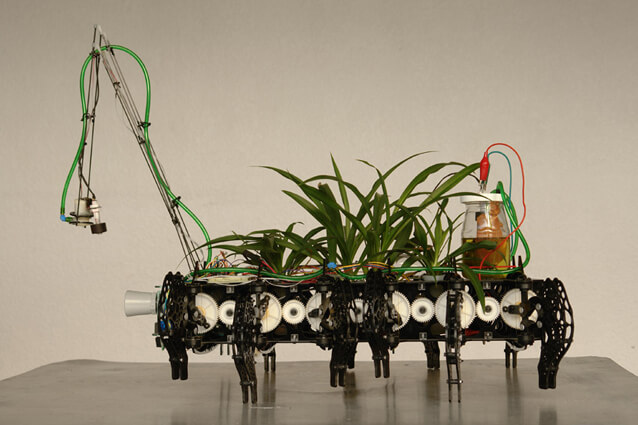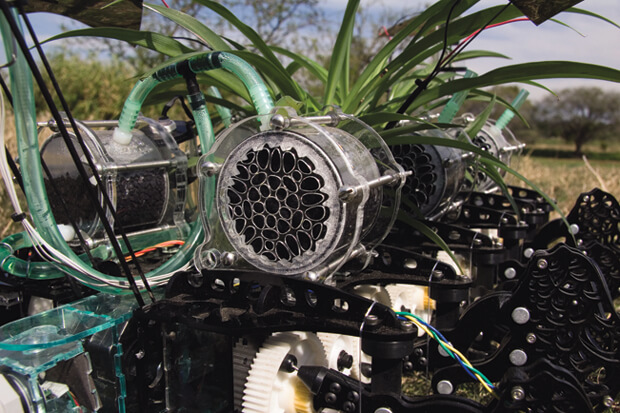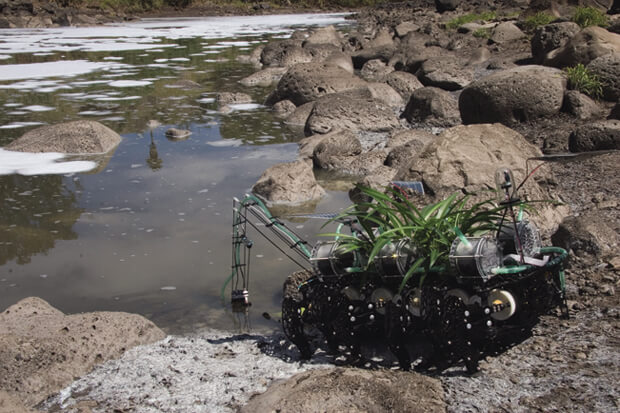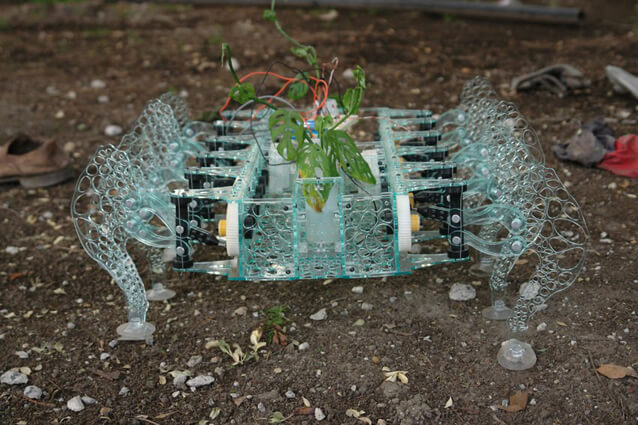Words by Meritxell Rosell
Gilberto Esparza is a Mexican visual artist whose works explore the interaction and impact of human technology with our environment through electronics, robotics and biotechnology. Water, energy, recycled consumer electronics, plants, bacteria, pollutants, and symbiotic ecosystems…are concepts and materials that blend harmoniously and elegantly in the hands of the artist.
In early works like urban parasites, small robotic creatures or insects explore the city space scavenging for any source of energy they can feed on. For Nomadic Plants, an autonomous robot holds a micro-ecosystem of plants and microorganisms, that is energy self-sufficient.
Through bacterial metabolic processes, the contaminant elements contained in the water are transformed into energy that powers the robot’s circuits. These nomadic plants are a disembodiment of our own species struggling to live in a deteriorated environment.
In his last project, Autophotosynthetic Plants, which was awarded the Golden Nica at Ars Electronica 2015, he takes from Nomadic Plants but on a much larger scale. It’s a perfect orchestration of metabolic processes, mixing bacterial, plant and animal biochemistry that integrates with a robotic interface.
In a self-regenerating system where contaminated water can be an energy source, it makes think us that these systems could be applied to cities, industries and communities.
Esparza’s work sets a series of experiments that aim to stimulate a critical discussion about life, social symbiosis, environment and urbanism, and how technology, which has brought us to this deteriorated situation, can actually save us from it.
You are an artist working at the intersection of art, science, nature and technology. When and how did the fascination with them come about?
I always have been interested in experimenting with different materials and languages, like sound, space, time, and interactivity. It was from there, that I started to set up sensors and motors in order to experiment with movement and the exhibition spaces.
This brought up the need to collaborate with electronic engineers, to better understand all the possibilities and apply those techniques to sculpture, mainly.
On the other hand, I’m interested in the dialogue that these technological artefacts can have with their environment with a critical reflection, like in works like Urban Parasites, Nomadic Plants and Autophotosynthetic Plants.
What was the most difficult part of Nomadic Plants’ development?
What makes me most enjoy the creation of a new piece are the technical challenges and the questions that arise.
To me, one of the major objectives of a piece of work is to learn new things. Nomad plants show us how to understand the complexity of living creatures’ metabolic processes and their symbiotic relationships with the environment.
This has made me think about how we can create nature-inspired systems that would help us establish a mutually beneficial relationship between the city and its milieu.
What directions do you imagine taking your work in?
At the moment I’m a member of “Sistema Nacional de Creadores de Arte” and I’m developing a project which will consist of testing samples of water from the most polluted rivers in Mexico, in order to study the quality of the water and also collect information about the area’s context: properties in the area, do interviews with the affected communities, scientists and activists…
In parallel to this, I am building a sonic instrument that will translate the bacterial activity in the river waters which can fluctuate according to different types of pollutants.
With the sound material and information from the research, a record will be made. A reference web page is under construction too, to be used by researchers or any person who is interested in knowing the situation of our rivers nowadays.
What are your aims as an artist working between art and science?
For me, it’s the collaboration with other disciplines, the dialogues to identify and understand which are the problems and what possible solutions can be created.
It is in this crossover where ideas are catalyzed and new research lines arise, not only to create a new piece of art but also to generate scientific knowledge and critical thinking.
This makes the piece of art to become an instrument for reflection with multiple interpretations that can contribute to a much more diverse audience.
What is your chief enemy of creativity?
TV.
You couldn’t live without…
Water.










